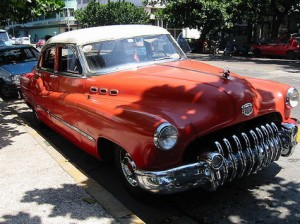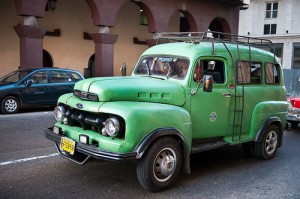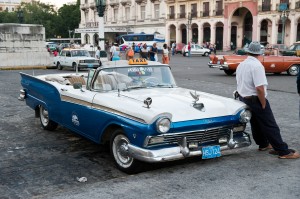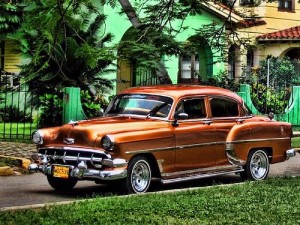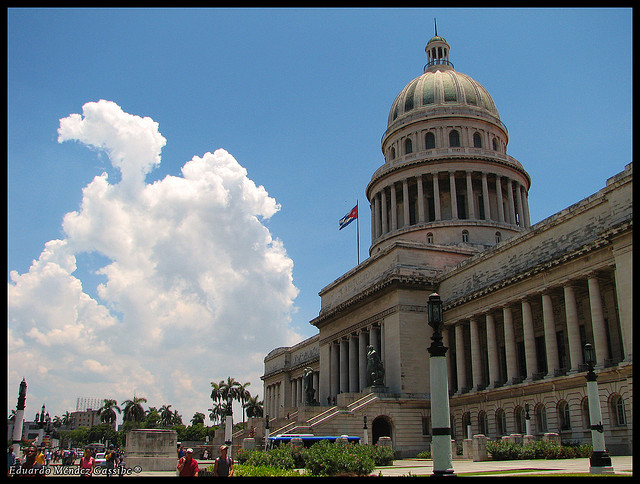Cuba’s streets are a huge rolling museum. Cars driven of all makes and models not imaginabled called “almendrones”. The need remains “alive” to most of them and only the ingenuity and creativity of the Cubans managed to keep them active. Ugly, noisy and a thousand and one adaptations contribute to some extent solve the problem of transportation and put a note in the picturesque cityscape.
Others, however, are so colorful and retain such originality in their lines and parts that could well be the collections of museum pieces, like the Auto Depot in La Habana Vieja, or exhibited in the Park Baconao Santiago de Cuba. Retained in the tank vehicles of all kinds-of walk, funeral, cargo … – remarkable for its antiquity, and others who owe their celebrity figures who used them as the Oldsmobile 59 of Commander Camilo Cienfuegos and other car the same brand, but in 1960, who used Celia Sánchez, and a 1930 Cadillac that belonged to former President Alfredo Zayas, and the VW-owned novelist Alejo Carpentier. In Baconao, a collection of over 1 500 models that mimic brands and models of cars from the nineteenth century, alternating with dozens of real samples like a Ford T 1912, an Austin Seven 1937-first minicar that took place in the world, and a Buick Skylark for 54 … 59 Chevrolet remains of Che Guevara Studies Center named the Heroic Guerrilla.
It is assumed that the oldest car in Cuba there is a Cadillac in 1902 and is part of the museum’s collection of Guanabacoa. A 1905 Cadillac is displayed in the Warehouse collection of Old Havana. On that day seven years ago that the new means of transport had made its appearance in the dusty streets of Havana: a noisy moving car with petrol and developed 10 km/h, a French Parisian thousand dollars cost to the owner. Six months later came the second car, an eight-Rochet & Schneider horsepower and a top speed displayed. A third car arrived shortly afterwards, this time a truck that was in the service of a cigarette company. With the beginning of the century Cuba also arrived to film and aviation, the electric trolley and dial telephone. Everything changed from night to morning, said Renee Mendez Capote the writer: from Spanish rule was passed to the agency of the United States. In the era of animal traction to the era of internal combustion. Expressions such as “engage the couple” to “get the car.” The reins at the wheel and the brake lever or pedal.
Everything from then precipitated. If in 1901 circulated through the streets of the capital 11 of these machines and the first car arrived in Santiago in 1902 and in 1913 ran for Havana over a thousand vehicles, and in 1916 accounted for 1 300 private cars, rental and 1 900 219 trucks. In 1958 Cuba was the sixth country in the world per capita average car. The outweighed, in this order, USA, Canada, Britain, Venezuela and West Germany.
Museum impossible
Many cars were on the road. They lost the trail because they were dismantled for parts used in other vehicles, or were turned into scrap metal out there, forgotten by all. Time swallowed.
Nothing is known, or at least does not know this writer, of the 1949 beige Chevrolet Fidel Castro used the election campaign in 1952, when he wanted a record of House Representative for the Party of the Cuban People (Orthodox). It seems to have lost forever the wedge blue convertible Packard brand, also from 1949, with Eduardo Chibas, president of that political organization, toured the island in their campaigns since.
On the death of Orthodox leader, in 1951, the wedge is kept in the garage of the building Chibas in Presidents Avenue corner 25, Vedado. From there, mysteriously disappeared after the coup of Batista on March 10, 1952. In recent years we have sought in vain to incorporate it into the funds of the Deposit of the Automobile.
Would be a futile search of the brave green Packard Pius Ángel Álvarez, a paradigm of “direct action” in the struggle against the dictatorship of Gerardo Machado, used in 1932 for endangering the life of Captain Miguel Calvo, head of the Section of Experts from the National Police. The young revolutionary and military are “hunted” each other for months. Pio gained the official one morning near the National Hotel, but the “experts” end up passing the bill in January 1933.
A man who, despite the early hour, killing time in the wall of the Malecon, told police that Calvo’s car, a Dodge Brother, had been shot from a green Packard, and from that time the authorities toiled in search of the vehicle information on the other hand, reported the press. After the action, Pius Alvarez hid the car in a garage in Marianao until days later I got to take him to San Miguel del Padrón to dismantle it and throw a lagunato parts. The historian Newton Briones Montoto in his book Direct Action , which details the event that during the journey, in a place where Pius forced traffic to slow down, a group of children shouted to his step, “Look, look at the Packard green ‘. Pius did not lose his poise. He parked the car next to a policeman and asked that required the boys because “this is not the car searched.”
The green Packard Pius Alvarez, disappeared by Pius, is part of an impossible car museum lost. Would make up this collection, among other vehicles, the Buick with particular sheet in which the President Prio left the Presidential Palace on March 10, leaving the mansion’s garage with the car registration palate 001, which was that of the Cuban leaders. And the armored Lincoln Machado left abandoned in their , the August 12, 1933. As such, there is another that does not appear, the General Alberto Herrera, head of the Cuban army in 1922 and joined Machado in his fall.
Another piece, and not less account, the museum imagined would be the already mentioned 16-cylinder 1930 Cadillac . New, it cost 25 000 dollars, but the Kid took his use in 1931 and paid for the vehicle more than 18 000 dollars. Years later he was offered 42 000, but the famed boxer said he did not settle for less than 60 000. At the end he was forced to get rid of it for very little money. Fuel consumed like a madman and the model was discontinued and its parts were difficult to obtain. In 1970 a car like the Cadillac of Chocolate worth more than $ 50 000.
Today, how much worth?
Sources: CiroBianchiRoss/InternetPhotos/TheCubanHistory.com
Cuba: The Museum of the Lost Cars / TheCubanHistory.com
CUBA MUSEO DE CARROS PERDIDOS
Las calles cubanas son un enorme museo rodante. Circulan por ellas automóviles de marcas y modelos inimaginables, los llamados «almendrones». La necesidad mantiene «vivos» a la mayoría de ellos y solo la inventiva y creatividad del cubano logran mantenerlos en activo. Feos, ruidosos y con mil y una adaptaciones, contribuyen a resolver en alguna medida el problema de la transportación y ponen una nota pintoresca en el paisaje urbano.
Otros, sin embargo, son tan vistosos y conservan tal originalidad en sus líneas, partes y piezas que bien podrían formar parte de colecciones museables, como la del Depósito del Automóvil, en La Habana Vieja, o la que se exhibe en el Parque Baconao, de Santiago de Cuba. En el Depósito se conservan vehículos de todo tipo —de paseo, fúnebres, de carga…— notables por su antigüedad, así como otros que deben su celebridad a las figuras que los utilizaron, como el Oldsmobile 59 del Comandante Camilo Cienfuegos y otro auto de la misma marca, pero de 1960, que utilizaba la recordada Celia Sánchez, así como un Cadillac de 1930 que perteneció al ex presidente Alfredo Zayas, y el VW propiedad del novelista Alejo Carpentier. En Baconao, una colección de más de 1 500 miniaturas que imitan marcas y modelos de automóviles desde el siglo XIX alterna con decenas de muestras reales como un Ford T 1912, un Austin Seven 1937 —primer minicoche que se produjo en el mundo— y un Buick Skylark del 54… El Chevrolet 59 de Che Guevara se conserva en el Centro de Estudios que lleva el nombre del Guerrillero Heroico.
Se supone que el automóvil más antiguo que existe en Cuba es un Cadillac de 1902 y forma parte de los fondos del museo de Guanabacoa. Un Cadillac de 1905 se exhibe en la colección del Depósito de La Habana Vieja. En esa fecha hacía ya siete años que el nuevo medio de transporte había hecho su aparición en las polvorientas calles habaneras: un ruidoso auto que se movía con bencina y desarrollaba 10 km/h; un Parisiense francés que costó mil pesos a su dueño. Seis meses más tarde llegaba el segundo automóvil, un Rochet & Schneider de ocho caballos de fuerza y que desplegaba una velocidad superior. Un tercer auto llegó poco después, esta vez un vehículo de carga que quedó al servicio de una empresa cigarrera. Con los inicios del siglo llegaban también a Cuba el cine y la aviación, el tranvía eléctrico y el teléfono automático. Todo cambió de la noche a la mañana, decía la escritora Renée Méndez Capote: del dominio español se pasó a la dependencia de los Estados Unidos. De la era de la tracción animal a la era de la combustión interna. De expresiones como «enganchar la pareja» a «sacar el automóvil». De las riendas al timón y al freno de palanca o de pedales.
Todo se precipitó a partir de entonces. Si en 1901 circulaban por las calles de la capital 11 de esas máquinas y el primer auto llegaba a Santiago en 1902, en 1913 corrían por La Habana más de mil vehículos, y en 1916 se contabilizaban 1 300 autos particulares, 1 900 de alquiler y 219 camiones. En 1958 Cuba era el sexto país del mundo en el promedio de automóviles por habitante. La superaban, en este orden, EE.UU., Canadá, Gran Bretaña, Venezuela y Alemania Occidental.
Museo imposible
Muchos automóviles quedaron en el camino. Se les perdió el rastro porque se desmantelaron para utilizar sus piezas en otros vehículos, los convirtieron en chatarra o quedaron por ahí, olvidados por todos. Se los tragó el tiempo.
Nada se sabe, o no lo sabe al menos este cronista, del Chevrolet beige de 1949 que utilizó Fidel Castro en la campaña electoral de 1952, cuando aspiraba a un acta de Representante a la Cámara por el Partido del Pueblo Cubano (Ortodoxo). Parece haberse perdido para siempre la cuña convertible azul marca Packard, también de 1949, con que Eduardo Chibás, presidente de esa organización política, recorrió la Isla en sus campañas de entonces.
A la muerte del líder ortodoxo, en 1951, la cuña se guardó en el garaje del edificio Chibás, en la Avenida de los Presidentes esquina a 25, en el Vedado. De allí desapareció misteriosamente después del golpe de Estado de Batista, el 10 de marzo de 1952. Durante los últimos años se ha buscado, en vano, a fin de incorporarla a los fondos del Depósito del Automóvil.
Una búsqueda inútil sería la del Packard verde que el corajudo Ángel Pío Álvarez, paradigma de la «acción directa» en la lucha contra la dictadura de Gerardo Machado, utilizó en 1932 para atentar contra la vida del capitán Miguel Calvo, jefe de la Sección de Expertos de la Policía Nacional. El joven revolucionario y el militar se «cazaron» mutuamente durante meses. Pío le ganó la partida al oficial una mañana en las inmediaciones del Hotel Nacional, aunque los «expertos» terminaran pasándole la cuenta en enero de 1933.
Un sujeto que, pese a lo temprano de la hora, mataba el tiempo en el muro del Malecón, comunicó a la Policía que el auto de Calvo, un Dodge Brother, había sido baleado desde un Packard verde, y a partir de ese momento las autoridades se afanaron en la búsqueda del vehículo; información que, por otra parte, divulgó la prensa. Después de la acción, Pío Álvarez escondió el vehículo en un garaje en Marianao hasta que días después lo sacó a fin de llevarlo a San Miguel del Padrón para desmantelarlo y arrojar sus partes a un lagunato. Cuenta el historiador Newton Briones Montoto en su libro Acción directa, que detalla ese suceso, que durante el trayecto, en un lugar donde el tráfico obligó a Pío a aminorar la marcha, un grupo de niños gritó a su paso: «Miren, miren el Packard verde». Pío no perdió su aplomo. Aparcó el auto junto a un policía y le pidió que requiriera a los muchachos porque «este no es el coche buscado».
El Packard verde de Pío Álvarez, desaparecido por el propio Pío, forma parte de un imposible museo de los autos perdidos. Conformarían dicha colección, entre otros vehículos, el Buick con chapa particular en el que el presidente Prío salió del Palacio Presidencial el 10 de marzo, dejando en la cochera de la mansión palatina el auto con matrícula 001, que era la de los mandatarios cubanos. Y el Lincoln blindado que Machado dejó abandonado en su huída, el 12 de agosto de 1933. Como ese, hay otro que tampoco aparece, el del general Alberto Herrera, jefe del Ejército cubano desde 1922 y que acompañó a Machado en su caída.
Otra pieza, y no de menor cuenta, de ese museo imaginado sería el ya aludido Cadillac 1930 de 16 cilindros de . Nuevo, costaba 25 000 dólares, pero el Kid lo cogió de uso en 1931 y pagó por el vehículo algo más de 18 000 dólares. Años más tarde le ofrecieron 42 000, pero el afamado boxeador dijo no transarse por menos de 60 000. Al final se vio obligado a deshacerse de él por muy poco dinero. Consumía combustible como un demente y el modelo estaba discontinuado y sus piezas eran difíciles de conseguir. En 1970 un auto como el Cadillac de Chocolate valía más de 50 000 dólares.
Hoy, ¿cuánto valdría?
Sources: CiroBianchiRoss/InternetPhotos/TheCubanHistory.com
Cuba: The Museum of the Lost Cars / TheCubanHistory.com



 Cuba: Museum of Lost Cars * Cuba: Museo de los carros perdidos
Cuba: Museum of Lost Cars * Cuba: Museo de los carros perdidos